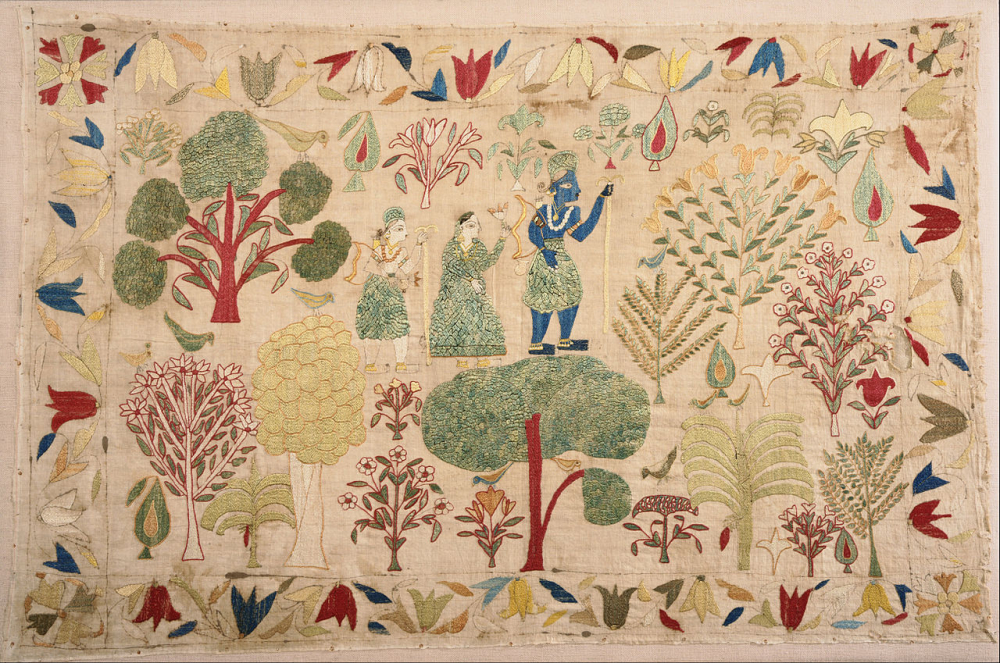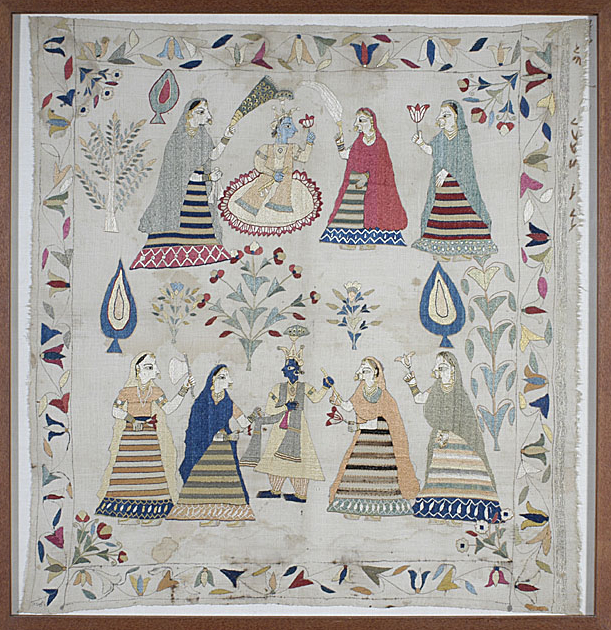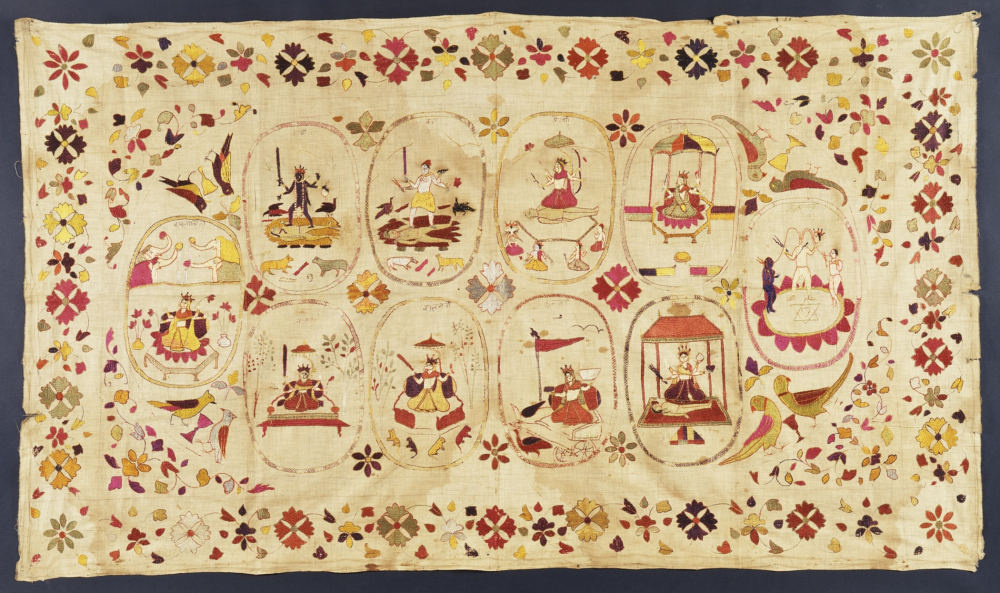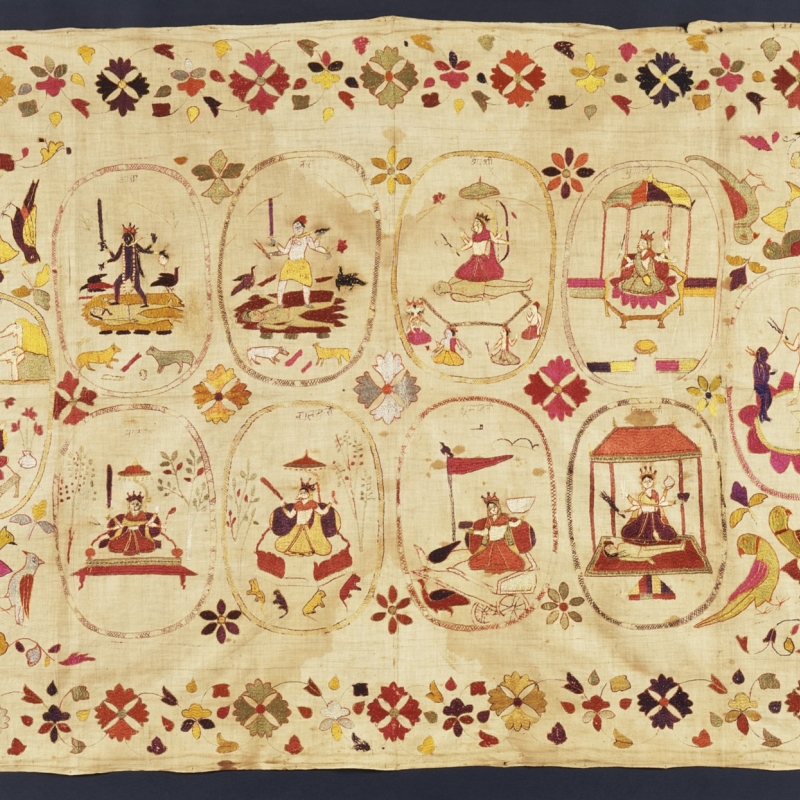Chamba rumals—which were used chiefly as decorative coverlets for platters filled with gifts in the hilly regions—started disappearing because of changing tastes and the availability of cheaper substitutes. Here, Prof. B.N. Goswamy writes about these Pahadi treasures, and the initiative to revive the craft. (Photo courtesy: Los Angeles County Museum of Art/Wikimedia Commons)
This article appeared originally in The Tribune, Chandigarh and is reproduced here with permission.
Ganesha, remover of obstacles, seated in ponderous majesty; nayikas stealing light-footedly out of their homes to keep a tryst; lovers locked in eager embrace; marriage pavilions with bridal pairs surrounded by precious dower; above all, Krishna dancing that eternal dance with the gopis, the circular raasamandala, the true place of which is the devotee’s heart: images such as these rise instantly in the mind as one thinks of those seductive, exquisitely coloured works, that are grouped under the deceptively simple rubric, Pahari Painting. But one often forgets that these images linger also in another medium, on a different surface: textiles. Most of them might appear a shade faded now—for time takes its stern toll—but on squares of fine cotton cloth, embroidered with silk threads, they keep turning up with equal regularity: delicately executed, rich in appearance and feeling, evocative of times gone by. And looking much like paintings. Chamba Rumals is what they are commonly called, for, even though they were produced in more than one region in the hills, they have come to be associated forever with the picturesque state of Chamba.

Not a great deal has been written on these ‘rumals’, even though nearly every writer on the hills notices them. They were used chiefly as decorative coverlets for platters filled with gifts, and one knows that high-born women, and those belonging to the folk, alike, embroidered them in their hours of leisure; one also knows that there are no early, dated rumals that have survived, but the craft is traditionally spoken of as going back to the 16th century; there are a few, very few, which bear inscriptions, giving the embroiderer’s name, a date, or the name of the person to whom the textile was meant to be presented.
Again, in respect of technique, the rumals have been analysed and discussed. The material used was, thus, fine muslin, and the embroidery was done with silk threads in soft colours; the stitches used were of the small, the ‘double darning’ kind, which appear evenly upon both sides of the fabric, achieving a double-sided or dorukha effect; the initial designs on the rumals, considering that most of them feature delicate figurative work, were generally drawn by painters; and, occasionally, ornamentation was added through the use of flat gilt-wire.
Also Read | Kapdagondas: Embroidery and Work
But all this is ‘information’, a dry inventory of materials and technique and practices. None of it comes even close to capturing the vividness, the sophistication, the sheer delicacy of these wonderful textiles. And it is only when one starts seeing them as an extension of paintings, as being their ‘sahodara’ in fact—‘born of the same womb’, in other words—that they begin to weave their gentle magic upon the viewer. Then images, and poetic texts, and the entire cultural context in which they were produced, start coming alive. One is aware of course that they are different from paintings, as much in respect of function and material, as of range and technique; and one realises that it is possible to speak of the one as being essentially aristocratic and classical, and of the other as ‘people-based’, or folk. But this exactly is what lends the rumals their great charm, for the feeling that they share with the paintings, despite the humbler materials they are made of and their simpler origins, is the same. In them, too, unfolds a magical world that needs to be seen with the ‘transfiguring eyes of love’, in A.K. Coomaraswamy’s famous phrase; and here, once again, as in paintings, "the arms of lovers are about each other’s necks, eye meets eye, and the whispering sakhis speak of nothing else but the course of Krishna’s courtship". In any case, in these rumals, the line that separates art from craft—naturally thin in the Indian tradition—begins to turn truly faint.

But, sadly, as in the case of the paintings, much of what one says here belongs to the past. The two ‘arts’ have languished now for years, although for different reasons. Painting in the hills virtually died out in the 19th century, in part owing to lack of princely patronage, and in part because photography, among other things, came in, changing tastes, raising expectations. The rumals, however, simply started disappearing, went out of fashion as it were, with time. Patronage here was not the issue: taste was, and the availability of cheaper substitutes in a society in which old ways of life and leisure had slowly begun to vanish.
Also See | Dongariya Kondh Embroidery
However, fortunately, in the case of the rumals, there have been efforts to revive the art/craft, as much for recovering the beauty that once was and for re-inducting the honesty of crafts into our lives, as for providing gainful employment to women in the hilly region. One of these efforts, made by the Himachal Pradesh Government which opened a centre for promoting the craft, went the way that most sarkari enterprises do: beginning well but quickly losing direction in the labyrinth of sad and tasteless paths. But what has come as a ray of hope is the determined project that the Delhi Crafts Council launched some years back. The group, which is involved in several other crafts projects too, went about this revival effort with imagination and resolve: establishing authentic materials, identifying age-old designs, locating craftswomen who either knew the work or were willing to learn. It was not easy, but if the exhibition of newly made Chamba rumals that the Council held two years ago at the Crafts Museum in Delhi was any indication, the effort was worth it. One could sense in the show a whiff of the pleasant old air, a vision of the colours that once glowed upon fabric. This exhibition, one understands, has been travelling ever since, and there are now indications that one will even see it in Chandigarh. One waits.

The Usual Carping
The Chamba rumals that the council showed were, I understand, also taken some months ago to Chamba itself, the home of the craft. The intention evidently was clean: to acquaint more and more people with the tradition, and the possibilities. But someone in that town did not relish the idea, and mounted a virulent attack upon it in the local press. Not because the work was not good, but because other considerations must have come in. Allegations of ‘exploitation’ were levelled; the council was seen as an interloper; questionable figures were quoted; greed was cited as the driving force. What could have been behind this? It is anybody’s guess. Petty local politics? Commercial insecurity? Or, that most Indian of all sins, envy?
This article has been republished as part of an ongoing series Art N Soul from The Tribune.













